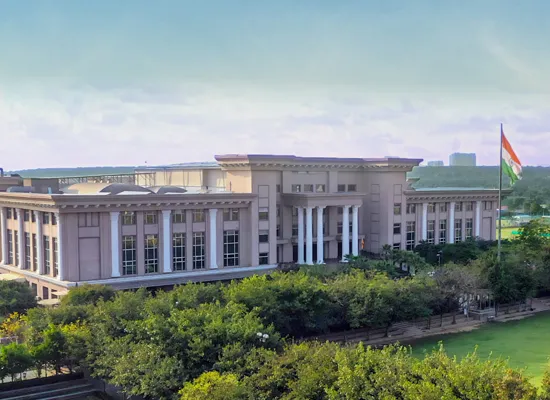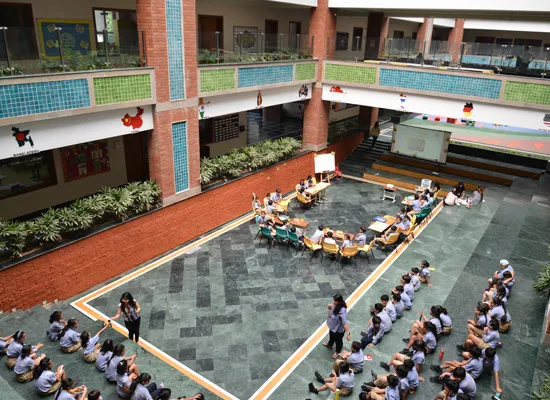Pathways School Gurgaon
Green Philosophy
The first K-12 school on Earth to achieve a LEED-EB Platinum Rating
The United States Green Building Council (USGBC) has recognised Pathways School Gurgaon for its Leadership in Energy and Environmental Design (LEED), thus conferring it with the honour of being the first school serving all grades K-12 in the world to achieve LEED-EB Platinum certification from USGBC. Among all educational facilities worldwide who have achieved this top distinction, which includes only one high school and a small number of university projects, Pathways School Gurgaon is the highest rated.
At Pathways School Gurgaon we believe that in addition to imparting holistic education, it is our duty to sensitise our students about sustainability – and what better way than to make them experience and immerse themselves in a sustainable lifestyle through their everyday activities at school.
Hence, when designing the school, we particularly emphasised on creating a green campus with zero discharge and a low carbon footprint. We took on the challenge of finding simple and unconventional approaches that take full benefit of natural energies and minimal use of complex technologies. This made the project more cost-effective as well, thus disproving the general industry notion that green buildings are inherently more expensive to construct. The design takes cues from traditional Indian architecture where old forts and palaces remained cool in the summers and warm in the winters even in the absence of modern technologies.
The results have been rather overwhelming:
- Our total energy requirements are 40% lesser than those of conventional buildings.
- Our total HVAC (Air Conditioning) requirements are 60% lesser than those of conventional buildings.
- We saved about 8-10% in construction costs too.
Given below are some of the salient features of our sustainable architectural design:
Ceiling Heights
As a normal phenomenon the cool air is heavy and stays down and the hot air is light and always travel up. We have concsiously kept the ceiling heights about 4.2 metres thus allowing the space for hot air. The Fan Coil Units are placed a little lower and send the cool air draft downwards thus not hitting the pocket of hot air trapped on the top.
Walls
All the exterior walls are constructed as Cavity Walls. There is a 9” thick brick wall on the outside, then an air gap ranging from 4” to 10” and then a 4.5” or 9” wall on the inside. Thermally during the forenoon until about 3 O’ Clock the exterior walls absorb heat. Then when the sun is on its way down, this heat starts entering inside the building. This Air Gap in the cavity wall does not let this heat enter inside the rooms thus the energy required to air condition the rooms is greatly reduced.
Conditioning of Circulation Spaces without providing equipments
While the classrooms are Air Conditioned, the corridors do not have any equipment provided. As we pump in the Treated Fresh Air in the rooms, maintaining the room pressure, the excess air spills out into the corridors and thus the corridors become comfortable. Further, non conditioned corridors also provide a buffer zone for students coming from warm outdoors and vice versa.
Central Atriums with Natural Ventilation on the top
As explained above, the hot air always rises up. The buildings are so designed that all the rooms open into a big courtyard having a huge Atrium. This Atrium has clear openings on the top. This naturally creates the ‘Chimney Effect’ and all the hot air from all the rooms and corridors travel up the Atrium and is vented out into the atmosphere automatically. This ensures comfortable conditions indoors and without any use of additional energy.
Windows
We keep a Window to Wall ratio about 35. Following techniques are used in terms of keeping such huge glazing area and still not letting the outside heat enter the rooms:
- Because of the air cavity total thickness of the outside walls are about 18” to 20”. Windows are then placed on the inner edge of the wall. This automatically gives a shade of 18” to 20” and thus the sun does not strike directly on the windows;
- The Window profile used is UPVC which has a U Value of 1.7;
- The glass is used in a Double Glazed Unit having 6 mm Reflective Glass on outside, 12 mm Gap filled with Argon Gas and 6 mm Clear Low ‘E’ Glass inside. Glass specification include U value of around 1.6, Solar Factor of around .35 and light transmission about 25%. The Low ‘E’, U Value and Solar Factor ensure that the outside heat does not travel inside the room. The 35% Window to Wall Ratio and 25% light transmission on one hand takes care of the glare thus no blinds/curtains are required and at the same time it ensures maintaining of sufficient Lux Levels inside the room and there is very less dependence on the artificial light.
Lighting
We prioritize energy efficiency with our lighting system, incorporating CFL and T5 lamps. Our carefully chosen luminaires feature mirror optics, directing light precisely where needed to minimize waste. We exclusively use electronic ballasts from reputable manufacturers. This approach not only harnesses the energy efficiency of CFLs and T5s but also reduces the necessity for additional luminaires thanks to the reflective properties of mirror optics.
Air Conditioning
In peak summers the ambient temperature ranges around 42 – 45 degrees in this part of the world. Inside the buildings the Central Air Conditioning system maintains a temperature of 24 degrees which is comfortable to Human Beings. Worldwide Air Conditioning consumes about 65% of the total Energy used in buildings. At Pathways we have very carefully taken certain out of the box measures that have resulted in reduction of HVAC load to great extent:
- Central Air Conditioning Plant consists of Chillers (Compressors) as the main Machinery. We use “Screw” chillers which give efficient power consumption even on part loads. The IKW is 0.62 per Tonne. The Refrigerant used is R134A which again is green compliant;
- While designing the Air Conditioning (HVAC) of a project, a careful working is performed determining the amount of Fresh Atmospheric Air to be pumped into the conditioned spaces. And since the temperature being maintained indoors is 24 degrees, it is the job of the Central Air Conditioning Plant to pick up the atmospheric air of 44 degrees, cool it down to about 23-24 degrees and them pump into the indoors. This consumes a lot of Air Conditioning Load and energy. Geothermally, 4 meters below the ground the temperature remains constant round the year. And this temperature is the average annual temperature of the place, which for the Delhi NCR is about 25-26 degrees. Therefore, we are routing the Atmospheric Air through Earth Air Tunnels 75 Metres Long buried 4 Meters below the ground. After travelling this 75 meters, this air picked up at 44-45 degrees cools down to about 28-30 degrees. Now we will cool this 28-30 degrees air to 24 degrees and pump inside. There are a total of 6 Earth Air Tunnels of 1200 MM dia provided and each tunnel is reducing the HVAC load by 30 TR each meaning a total reduction of 180 TR. This results in less power consumption thus reducing the carbon footprint considerably;
- In a school environment there are various timings at which various facilities operate. And at the same time it is very difficult to ensure that the air conditioning and lights of the respective areas are properly switched off during these off hours. Here we regulate the electricity through a PLC (programmable Logic Computer) which shuts off the supply at the non usage hours thus ensuring no wastage at all;
- While we have saved the electrical energy by the above measure, there is still a lot of energy losses that happen with the chilled water flowing through the multi kilometer of chilled water lines irrespective of wherether the equipments of particular areas are being used or not. This is a passive loss which no one takes into consideration but has a huge impact on the Main AC Plant load. To arrest this, according to the usage time and pattern, we have devided all our buildings into various zones and intelligentally designed the chilled water piping providing motorised butterfly valved at the chilled water return of each zone. The PLC at the time of shutting the electricity of the non operational zone also shuts off this motorised valve thus cutting off the chilled water to unnecessarily run in the pipe lines of this zone. Thus on one hand reducing the pumping load and on the other arresting the unnecessary energy losses that otherwise are incurred with the excess flow of water in the non operative areas;
- All the Fan Coil Units and Air Handling Units are fitted with Pressure Independent Balancing Cum Control Valves that regulate the flow of water required thus optimising the flow which results in reduced Water Flow and hence saving in Pumping energy;
- All the Floor Mounted (AHUs) Air Handling Unit are fitted with Variable Frequency Drives which regulates the Air Flow according to the requirement. This optimisation reduces the total tonnage required for the (AHU) Air Handling Unit and hence reduces the load on the Chillers;
- All the pumps are fitted with Efficiency Class 1 Motors which give a better energy efficiency which further increases on part loads:
- Cooling Towers are selected with Lower Approach. This reduces the Condenser Water Temperature which in turn reduces the power consumption of chillers. Further the Towers are so designed where the highly efficient fans are selected which consume less power. For a 275 TR Cooling Tower, the total Fan KW is just 7.5;
- Condensate Water Collection and Usage. Normally in any HVAC facility the condensate water is channelised to the drain and goes waste. And actually this is near Distilled quality water and that too at a very low temperature. We have chanellised and collested the condensate water of all the (FCUs) Fan Coil Unit and (AHUs) Air Handling Unit into a single tanle which then pumps this cold water to the cooling tower as the make up water. This on one hand utilises the water which otherwise goes waste. And on the other hand, providing chilled water to the Coolong Tower increases the effivciency of Chillers Condensate water by abut 6% resulting in huge power savings.
Indoor Sports Arena
Indoor sports areas necessitate a heightened requirement for fresh air. Yet the comfortable temperature has to be maintained for the sportsmen. We have used natural methods in attaining these. The indoor sports Arena are constructed in the Lower Ground Floor about 3 metres below ground level. This naturally keeps the temperature in moderate levels. Along with that we have also introduced 50000 cfm of Fresh Air through Earth Air Tunnels which cools the Indoor Sports Arena. This way we are cooling these areas with 100% fresh air without any use of Chilled Water thus absolutely no load on the HVAC system.
Swimming Pool
Like the Indoor Sports Arena, the Swimming Pools are also constructed in the Lower Ground Floor about 3 metres below the ground. Since these pools are heated for all weather use, this placement, to a good extent, naturally takes care of the temperature of the water.
- Pool Heating: Then for the winter heating, instead of going in for boilers we have gone for energy efficient Heat Pumps. The winter heating requirement of ours is about 300 KW. In case we had gone in for boilers, they would have incurred a power consumption of about 350 KW as boilers run on about 85% efficiency (which further keeps on reducing with times) and (COP) Coefficient of Performance is almost 1. ‘By switching to the Heat Pumps, this power requirement has come down to just 60 KW as the Heat Pumps work on a COP of 5 and in this case the efficiency increaes by the times’ to ‘By transitioning to heat pumps, the power requirement has been reduced to only 60 kW. This is due to the fact that heat pumps operate with a coefficient of performance (COP) of 5, resulting in a significant increase in efficiency’ Further during non-operational hours the pool is covered with the Isothermic Pool Cover thus conserving the heat within the pool and just a fraction of heat pump is operated to maintain the heat level;
- Pool Ventilation: Out of the air with which the Indoor Sports Arena are cooled, about 8000 cfm is directed to the swimming pool for ventilation and maintaining the humidity levels. Using this technique has saved us from putting De-Humidifyers and a separate Ventillation System which otherwise would have consumed about 25 KW of power.
This has resulted in a saving of about 310 KW of load.
Plant Room placement and cooling
The Plant Room has been constructed in basement adjascent to the Indoor Sports Arena/Swimming Pool. This automatocally takes care of the conditiones inside as basements are always cool in summers and comfortable in winters. Further to ensure that the Deisel Generators run with optimum fuel consumption, their ventilation with cool air is utmost important. In normal cases Air Washers are installed in the Plant Room to provide cool air for DG Sets ventilation. Here we have achieved this without any equipmemt installation in the following ways:
- Out of the 50000 cfm air that cools the Sports Arena above, 42000 cfm is routed and left over the DG Sets thus taking care of the DG Sets cooling;
- Rest 8000 which is used for Swimming Pool Ventilation becomes much more cooles with the fumes and is channelised to cool the complete plant room;
- The cooling tower at the terrace though cool the condensor water but also in the process throw a huge amount of cool air in the atmosphere. We have trapped this cool air going out of the cooling tower and brought it to the DG Sets installation thus adding onto the DG Ventillation.
By doing these measures we have done the Plant Room Cooling and DG Sets Ventillation without installing any equipment but using the cool air which otherwise would have thrown away. This has resulted in saving to the tune of about 85 KW of equipments which otherwise would have to be installed.
Horticulture
Pathways campuses are huge land areas. The residential campus is 32 Acres and the other two campuses are over 10 Acres each. Here we do a ground coverage of only about 22%-25% and rest of the areas are open spaces, playfields, plantations etc. Thousands of trees of varied species are planted on the open areas. These plantations are strategically deployed. There is a dense plantation along the boundary walls mainly of trees that grow good height and are dense. So any air entering the campus is filtered through these trees. Further there is dense plantation done on the periphery of all the buildings which cuts the heat and keeps the buildings cool. Regular watering of these trees creates evaporation which in turn creates a cooler atmosphere.
Rain Water Harvesting
Being huge campuses ranging from 32 Acres to 10 Acres and having huge terrace areas of buildings, all the storm water is channelized into the intelligently designed storm water drain network. The network is so designed that it not only accommodates the water that comes through rain in the campus area, but also the water that flows inside the campus because of the natural terrain and nallas from surrounding areas. This network then guides water again to the natural nallas to go out of the campus. Enroute good numbers of rain water harvesting pits are built and are strategically located near to a Bore Well so that these borewells get the recharge. All these years we have seen Bore Wells in the surrounding areas getting dry, but ours always remain charged and this is only because of the Harvesting System we have deployed.
Roofs
Terraces are open to the sun heat and radiate a lot of heat inside. This increases the airconditioning load on the top floor of the building. Here again we go the natural way. We lay the Brick Bats over the RCC Roof for insulation. This is then plastered and then on top, broken China Mosaic of White and light colours are layed. This china mosaic reflects the heat from the sun and being of light colours do not absorb any heat either. And whatever little is left, the Brick Bats take care of not passing it through.
Sewage Treatment
Watering such huge green campuses requires a lot of water. Here we meet about 80% of the requirement just by recycling the waste water. The Sewage Treatment Plant is designed to use least of chemicals and power. Total power required to run a 150 KLD Plant is 7.5 KW thus saving huge power costs. All the waste water is channelised to the in house Sewage Treatment Plant installed. All this sewage is treated in such a way that only a very little amount of sludge is left and all the water is treated and filtered with appropriate chemical properties to be used for horticulture. This water then is supplied to the carefully designed irrigation system which is designed after carefully assessing the amount of water required in various greens and plants. And the water that comes out from the STP is so rich in minerals that practically we do not require to use any fertiliser and the plants are always lush green!!Thus, we are not drawing any fresh water for irrigation.

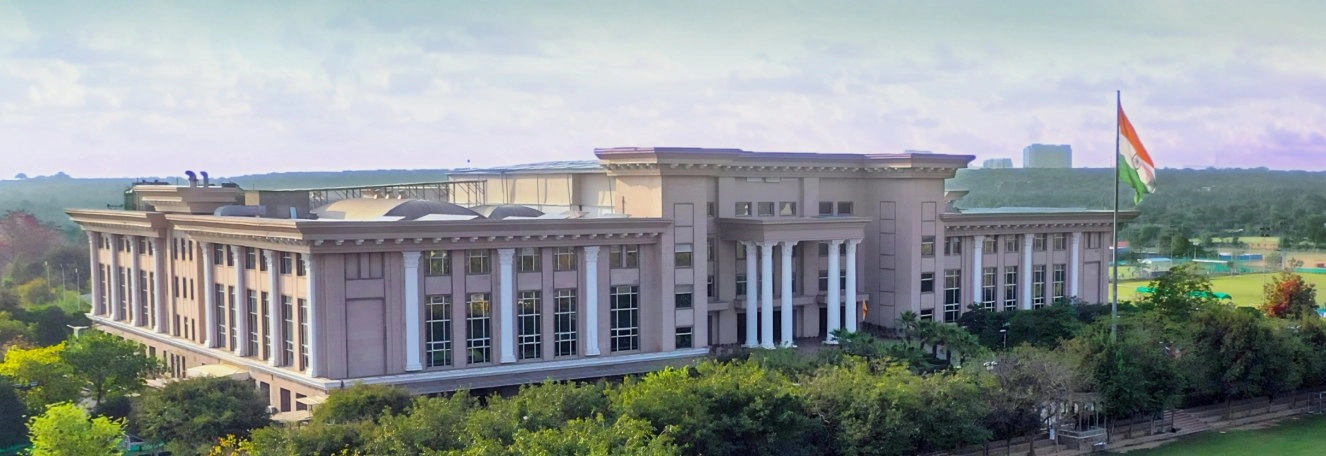
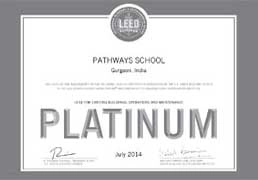
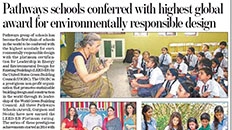
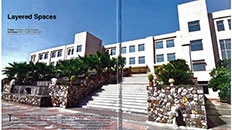
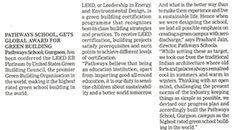
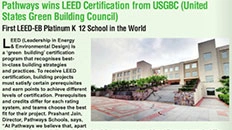
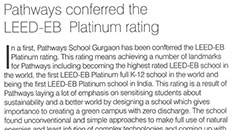
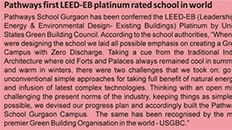
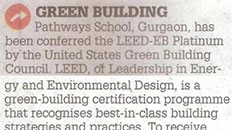


 Baliawas Off Gurugram Faridabad Road, Gurugram – 122003
Baliawas Off Gurugram Faridabad Road, Gurugram – 122003




























